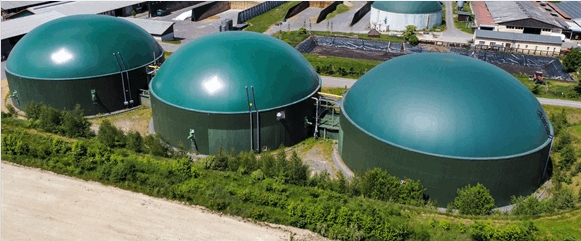
BP plc’s Archaea Energy has officially launched its Archaea Modular Design (AMD) renewable natural gas (RNG) plant in Medora, Indiana.
The Medora plant captures the gas from a landfill owned by Rumpke Waste and Recycling and converts it to electricity, heat, or renewable natural gas, which “leads to cleaner air, less odor, and more sustainable energy when compared with traditional fossil fuel energy”, BP said in a news release. The plant is the first to come online since BP’s acquisition of Archaea in December 2022.
BP said the Medora plant can process 3,200 cubic feet of landfill gas per minute into RNG, which is enough gas to heat around 13,026 homes annually, according to the U.S. Environmental Protection Agency’s Landfill Gas Energy Benefits Calculator.
According to BP, RNG plants have been custom-built traditionally, but AMD allows plants to be built on skids with interchangeable components. Using a standardized modular design leads to faster builds than previous industry standards, the company added.
“What we are doing at the Medora plant is phenomenal and it’s just the beginning of what’s to come at Archaea”, Archaea CEO Starlee Sykes said, “This is a powerful step forward in our net zero journey to capture landfill emissions and provide customers with lower emission, lower carbon fuel. Our goal is to safely bring several AMD plants online this year. I’m in awe of our team who designed, engineered, and built this facility and we can’t wait to bring more online across the US”.
“Our family company is constantly looking for technologies to lessen our overall impact and further our efforts to protect and preserve the environment”, Rumpke Waste & Recycling Area President Jeff Rumpke said. “The addition of Archaea Energy’s RNG plant at our site will help further reduce emissions and give residents and businesses assurance that their waste is not only being properly disposed of – but also being put to good use”.
BP said it became the largest producer of RNG in the USA with the acquisition of Archaea. Bioenergy is one of five strategic transition growth engines that the company intends to grow rapidly through this decade, expecting to deliver around $2 billion EBITDA in 2025 and aiming to deliver more than $4 billion in 2030. In addition to bioenergy, BP’s transition growth engines include convenience, electric vehicle charging, renewables & power, and hydrogen. The company expects to invest up to $8 billion more in its transition growth businesses this decade to reach more than 40 percent of its total annual capital expenditure by 2025, aiming to grow this to around 50 percent by 2030, according to the release.
In September, BP started construction on its 187 megawatts defined conditions (MWdc) Peacock Solar project, located 10 miles north of Corpus Christi in San Patricio County, Texas. Peacock will sell all of the electricity it generates under a long-term power purchase agreement to Gulf Coast Growth Ventures (GCGV), a joint venture between ExxonMobil Corp and Saudi Basic Industries Corporation (SABIC), which produces materials used to manufacture clothes, food containers, packaging, agricultural film, and construction materials, BP said in an earlier news release.
Meanwhile, hydrogen technology company Advanced Ionics closed a $12.5 million Series A financing led by BP ventures, with additional investors including Clean Energy Ventures, Mitsubishi Heavy Industries, and GVP Climate, according to a separate BP news release.
Advanced Ionics is a developer of a new category of hydrogen electrolyzers useful for expanding green hydrogen production. The new capital will help catalyze Advanced Ionics’ growth and facilitate the initial deployment of its Symbion water vapor electrolyzer technology for heavy industry. Water vapor electrolyzers address two of the biggest obstacles to expanding green hydrogen production: cost and electricity requirements, according to the release. The company’s water vapor electrolyzer helps reduce the cost and electricity requirements for green hydrogen production by symbiotically integrating with standard industrial processes to harness available heat.